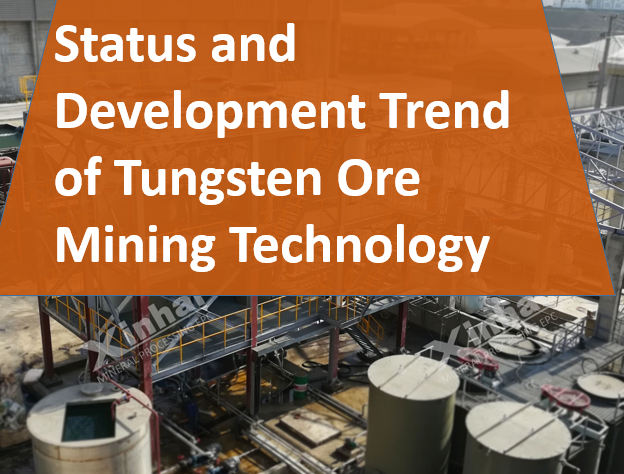Status and Development Trend of Tungsten Ore Mining Technology
2025-04-23 Xinhai (623)
2025-04-23 Xinhai (623)
If you have any questions, please contact us through the following ways, we will give you more and better assistance!

As an indispensable strategic resource for modern industry, tungsten ore is widely used in aerospace, electronics, machinery manufacturing and other fields due to its high melting point, excellent electrical conductivity and corrosion resistance. With the surge of global demand, efficient and environmentally friendly mining technology has become the core of industry development. This paper focuses on the current situation of tungsten mining technology, and systematically combs through the mainstream technology and its application, with a view to providing reference for the optimisation of industry technology.
Tungsten ore resources have significant geographical characteristics, and are mainly distributed in China, Russia and Vietnam, with South China ranking first in the world in terms of reserves. There are various types of tungsten deposits, including magmatic, sedimentary, metamorphic and hydrothermal types, and their formation is closely related to regional geological evolution. Ore often exists in the form of single mineral or symbiosis with other metals, and the microstructure directly affects the selection of ore dressing and smelting process.
1. Traditional mining technology
(1) Open pit mining
Open pit mining is suitable for shallow surface, thick ore body and high grade deposits. By stripping the overburden, blasting and crushing the rock, it is mined layer by layer by using excavators, trucks and other equipment. The advantage lies in low cost and simple operation, but it is easy to cause ecological damage to the surface.
(2) Underground mining
For deep deposits, commonly used methods include:
Room and Pillar Method: retaining pillars to support the roof and mining the ore in stages, with high safety but low resource recovery rate.
Filling method: backfill the mining area with waste rock or cemented material after mining to reduce ground settlement and environmental impact.
Layered chipping method: mining in layers from top to bottom, suitable for thick and large ore bodies, and requires precise control of the chipping process.

2. Modern mining technology
(1) Mechanised mining
Automated drilling machines, intelligent loaders and unmanned transport systems are introduced to achieve continuous and large-scale production. For example, the coordinated operation of shovels and trucks can optimise the transport path and reduce energy consumption; the automated sorting system improves the efficiency of ore grade classification. Mechanization technology significantly improves mining safety and reduces manual labour intensity.
(2) Informatization and intelligent mining
Relying on the Internet of Things, artificial intelligence and three-dimensional modeling technology, the construction of mine ‘digital twin’ system:
Real-time monitoring: sensor network to collect temperature, pressure and other data, early warning of safety hazards.
Intelligent decision-making: Optimise blasting parameters and equipment scheduling through algorithms to improve mining accuracy.
Unmanned operation: unmanned transport vehicles and remote control drilling rigs to adapt to extreme mining environments.
3. Special Mining Technologies
(1) Deep Chemical Mining
For low-grade and complex structural deposits, tungsten minerals are dissolved by injecting acidic or alkaline solutions, and transformed into recoverable tungstate solutions. This technology requires precise assessment of geological conditions, and the selection of chemical reagents and metal recovery process are key.
(2) Microbial-assisted mining
uses specific microbial metabolites (e.g. acids) to dissolve ores and release metal ions. For example:
Bioleaching: Microbial acid production dissolves metal sulphides, suitable for low grade ores.
Bio-oxidation: catalyses the oxidation of sulphides to soluble sulphates. This technology is environmentally friendly, but needs to optimise the culture conditions of bacterial strains.
Resource Depletion and Grade Decline: locate hidden ore bodies through high-precision exploration technology (such as three-dimensional modelling), and research and develop high-efficiency sorting process for low-grade ores.
Pressure on environmental protection: promote green technologies such as dry beneficiation and bio-mining, and strengthen mine reclamation and ecological restoration.
Conflict between cost and benefit: improve automation level to reduce labour cost, and introduce intelligent energy management system to optimize energy consumption.
Conclusion
The current tungsten mining technology is moving towards the direction of high efficiency, intelligence and greening. Optimisation of traditional technology and integration of modern technology is the key to improve resource utilisation, while innovative technologies such as microbial mining and deep chemical extraction have injected new impetus for the sustainable development of the industry. In the future, it is necessary to continue to increase investment in technology research and development, balance the economic, ecological and social benefits, and promote the tungsten mining industry towards high-quality development.